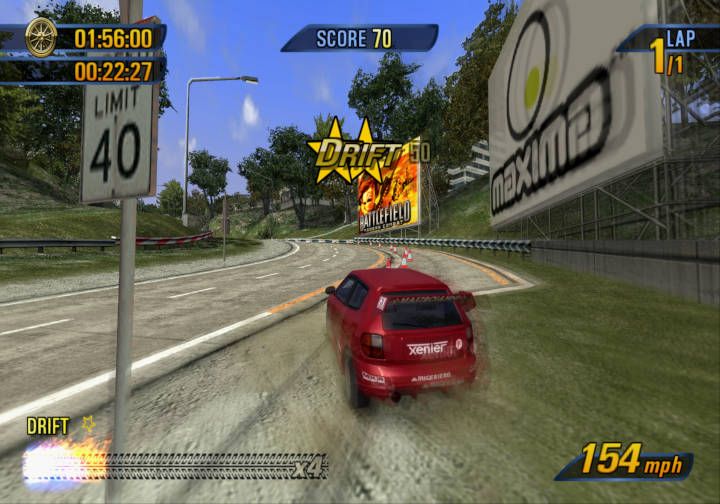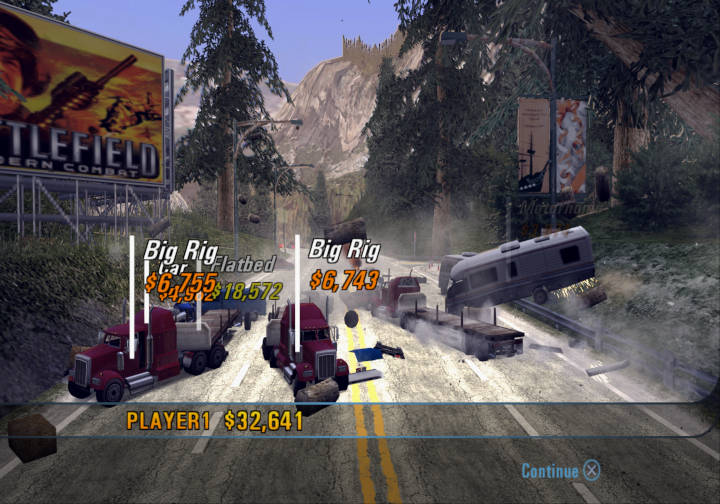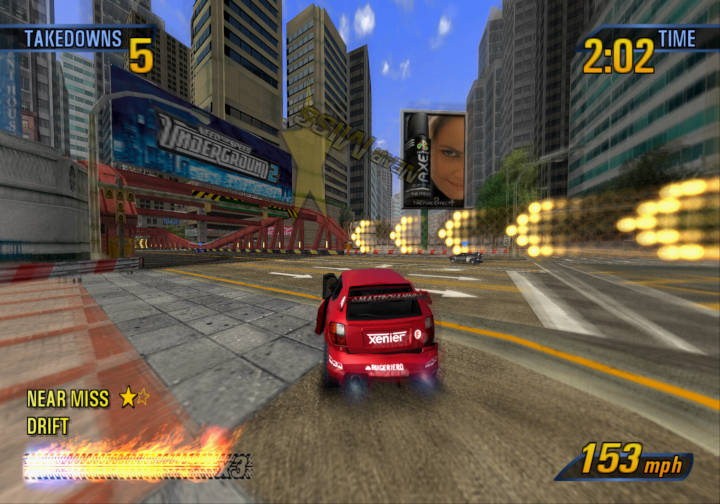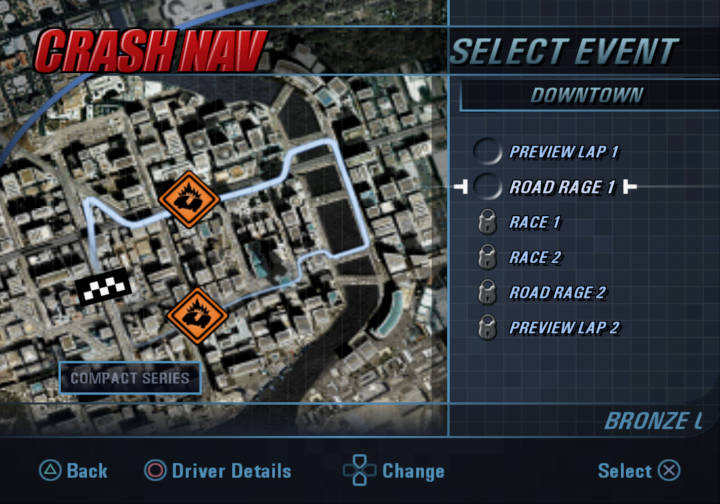Review: Burnout 3 Takedown
Hey…(hey)…you…(you)…get outta my mind! #
I lost my Burnout virginity at a friend of a friend of a friend’s house.
The reason I beg two degrees of separation is this particular troupe were big into drinking lukewarm super stubbies, mugging their arms around each other’s shoulders, and chanting Oasis lyrics into the salted fish air of my coastal hometown. Teenage kicks, right through the night, indeed.
You see, 2004’s Burnout 3: Takedown, with it’s play-list of edgy alt indie rock tunes had this special feature whereby you could import your own MP3 songs.
And I’m sure you can see where this is going: Barely post-pubescent bawling of “Wonderwall” whilst blistering car paint-jobs against blurring in-game walls.

Satiating a Need for Speed #
Firetrap, grunge, and other post-cool baggy clothed early Aughties aesthetic styling aside, my eyes melted into the deep tube TV in awe at the sheer feeling of speed, the intensity of colours, the sharp focus and soft edges. This racing game—a genre I normally hold little interest in—looked and felt better than real-life.
Drifting around giant swathes of American alpine and urban multi-lane highways (other worldly locales unlocked later); boosting into the side and rear-end of enemy cars; shunting rivals into cars, pillars, trucks, barriers, buses, and blunt concrete faces. Or gunning it through straight tunnelled sections, the THX quality sound-effects whooshing over you.
There is a real sense of inertia, mass, and gravity to the cars. Nitro-boosting to what still feels like 400 MPH in little pocket rocket cars. Blue flames licking out exhaust pipes. Weaving between oncoming cars, planning a route a split-second ahead in early detection of the pin-prick of car-bound headlights.
All at an effortlessly creamy 60 frames per second. Even split-screen at 30 frames per second feels robustly fantastic (and caused frantic hilarity in good company).
The entirety of the driving experience is perfectly encapsulated into these lovely bite-sized levels, each with a clear objective and bronze-silver-gold ranking, whether it be plain racing, head-to-head, time-trials, or my favourite: road rage (destroy a horde of enemy cars in a time-limit).
Even in death, you can cause more damage. A feature called impact time or crash after-touch allows you the god-hand of gently forcing your smouldering wreck in any direction, in slow-motion, as a disturbing and ethereal chorus of smashing glass, metal friction, and a choir of paranormal voices spookily nudges your car into another racer’s, causing them to be “taken out” by you posthumously. (Well, until you re-spawn a millisecond later with a depleted or refreshed nitro boost bar.)
Crashing + Diorama = Crashorama? #
To contrast the meandering curves and looping sprawls of speed, there are static, terminating crash events too. Unique diorama levels where you launch yourself at a junction, grabbing multiplier tokens and speed boosts on your way to destroying as many vehicles you can come into direct contact with, or by proxy, smash other cars into each other in a horrific pile-up.
Video games are an abstract medium, with abstract layers. Much like in military shooting games, you’re essentially playing tag. You’re not imagining the pixels and polygons represent a human being with a loving family at home, keenly awaiting their return. There’s no simulation here of people who will mourn their passing at the hands of your virtual gun, or in the case of Takedown, the missile that is your car versus other driver-less cars.
No humans were harmed in the rampant twisting of fake metal and exploding fuel tanks. It’s not carnal carnage with cars. It doesn’t inspire dangerous driving in real-life. You’re just trying to catch all the vehicles in your drag-net of destruction, towards achieving a shiny gold pixelated medal.

So, rack up millions of dollars in damage to unlock faster and heavier cars, and listen to the Marmite game MC announcer “Striker”, as he welcomes you to yet another event via “Crash FM”, stitching together the soundtrack a la Queens of the Stone Age - Songs for the Deaf.
Playing Now (Original/Emulation) #
Revisiting this game every year always brings the same pleasure as that love at first sight moment. Enough even to overcome the Oasis-stained, Lynx body spray and hair-gel rooted memories of my youth. Coincidentally, I found a Lynx/Axe billboard within the PS2 version, posted alongside ads for Need For Speed 2: Underground, and Battlefield adverts. A time before targeted ads, EA clearly had a target demographic.

Regardless of anti-aphrodisiacs, I do have the original game disc for PS2, and the XBOX version via an archaic XBOX 360 backwards compatible digital purchase. Through the wonders of technology, you can also emulate using the PS2 game disc on PC via PCSX2. This is the version I’m playing with nowadays on my old i7 3700K / GeForce GTX 980 Ti at 2560×1440 resolution. There’s even a fan-made widescreen patch which I just discovered when capturing screenshots for this article.
If you do emulate via PCSX2, there’s an issue where the sky doesn’t render and leaves a black void (Issue #563). Easy-fix is this: Simply make sure before you choose a course to play, make sure you’re using the software renderer (F9 keyboard shortcut to hot-switch between software and hardware), then once loaded, you can switch back to hardware rendering using the F9 keyboard shortcut.
Apparently there is good XBOX emulation too these days via Xemu. Alas, I don’t yet have the XBOX DVD version to dabble with this.
Downhill… #
The only peculiarity I find is that no other Burnout game I’ve played since has come close to this majestic third title. The PSP entry Legends was an admirable facsimile; I couldn’t get past the agonisingly slow hand-holding tutorial of Dominator (PSP); and 2008’s Paradise felt loose, bloated, and bland in comparison.
Driving between events with a Sat-Nav feels too real and mundane in comparison to the immediacy of Takedown’s neat, large-type menus. A couple of clicks and a few seconds to load. Straight into 2–5 minutes of being in “the zone”, seemingly hard-wired to the brain’s hormonal drip-cycling of adrenaline and dopamine.

How did it all go so wrong in the 4 years following Takedown? Too slow, too fast, too dull. Never feeling natural or connected again.
The recent 4K HDR conversion of Paradise even makes it frustratingly hard to visually decode at speed (on my OLED at least), with far too much contrast and shadow. As the game wasn’t designed for it, changing gamma/brightness/contrast settings just washes it out. Ultimately, I was almost immediately bored with the free-roaming, unfocused road network of Paradise, and that’s the death-knell of any game for me these days. Hook me in twenty minutes or I’m bouncing off elsewhere (unless there’s some seriously strong recommendations from trusted friends to persevere, as was the case for me and Nier: Automata; another story for another day).
And so, the sense of fun and velocity escaped the Burnout series in such a rush. Perhaps the timeless, zen-like state of flow that is 3 can be captured once more in a reincarnation? I should really try Dangerous Driving, the spiritual successor to Takedown from members of the original Criterion development team. They even have a sequel on the way: Dangerous Driving 2. Could it really surpass Takedown in its purity and simplicity, sound, and motion?
Oh the times, they are a-changing. Except, they’re not. At least, not yet. The now 17 year-old Burnout 3 is still my favourite driving game ever, and remains as excellent as it ever was. If you’ve never had the pleasure, there are very few games I can recommend as highly as this one, regardless of your tastes: Burnout 3: Takedown is a must play.
This review was originally featured as a guest post over at Super Chart Island.
- Read the next post: “2022 Every Day Carry (EDC)”
- Read the previous post: “A CRT Story”
- Or roll for a random post